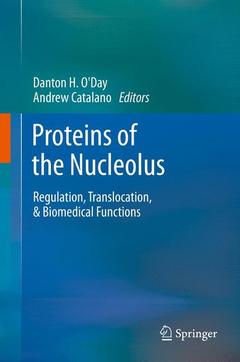Proteins of the Nucleolus, 2013 Regulation, Translocation, & Biomedical Functions
Coordonnateurs : O'Day Danton H, Catalano Andrew

Part I Introduction.- Chapter 1 Proteins of the nucleolus: An introduction.- 1.1 Introduction.- 1.2 Functional consequences of nuclear and nucleolar architecture (Chapter 2).- 1.3 rDNA and nucleologenesis in Drosophila (Chapter 3).- 1.4 The nucleolus of Dictyostelium and other lower eukaryotes (Chapter 4).- 1.5 Human rDNA genes: Identification of four fractions, their functions and nucleolar location (Chapter 5).- 1.6 Chromatin organization and the mammalian nucleolus (Chapter 6).- 1.7 Chaperones and multitasking proteins in the nucleolus (Chapter 7).- 1.8 Nucleolar localization/retention signals (Chapter 8).- 1.9 Nucleolar transport of putative GTPase GNL1 and related proteins (Chapter 9).- 1.10 Nucleolar protein anchoring and translocation (Chapter 10).- 1.11 The nucleolus as a stress response organelle (Chapter 11).- 1.12 The nucleolar aspect of breast cancer (Chapter 12).- 1.13 Cysteine proteinase inhibitors in the nucleus and nucleolus in activated macrophages (Chapter 13).- 1.14 Nucleolar proteins and cancer: The roles of Aurora A-interacting nucleolar proteins in mitosis and cancer (Chapter 14).- 1.15 Nucleolar transplantation and human embryogenesis (Chapter 15).- 1.16Conclusion.- Part II The nucleolus and nucleolar proteins.- Chapter 2 Functional consequences of nuclear and nucleolar architecture.- 2.1 General aspects of nuclear architecture.- 2.2 Nuclear architecture and epigenetic events during replication.- 2.3 General function and structure of nucleoli.- 2.4 Conclusions and future directions.- 2.5 Acknowledgements.- 2.6 Abbreviations.- 2.7 References.- Chapter 3 rDNA and nucleologenesis in Drosophila.- 3.1 Introduction.- 3.2 Nucleolar organizers contain rDNA genes.- 3.3 The Drosophila rDNA repeat unit.- 3.4 X-Y chromosome pairing in male meiosis is mediated by the 240bp IGS repeat.- 3.5 Growth-related expression of Drosophila rDNA.- 3.6 Centric heterochromatin flanking the NORs.- 3.7 Endo-replication of Drosophila rDNA.- 3.8 The bobbed mutation and rDNA magnification.- 3.9 rDNA compensation.- 3.10 Early work on R1 and R2 retrotransposons.- 3.11 Drosophila rDNA and epigenetic effects.- 3.12 Nucleologenesis in Drosophilamelanogaster.- 3.13 Future endeavors.- 3.14 Acknowledgements.- 3.15 Abbreviations.- 3.16 References.- Chapter 4 The nucleolus of Dictyostelium and other lower eukaryotes.- 4.1 The nucleolus of Dictyostelium.- 4.1.1 Dictyostelium nucleolar structure during growth.- 4.2 Nucleolar proteins in Dictyostelium.- 4.3 The nucleolus in other lower eukaryotes.- 4.4 Conclusions.- 4.5 References.- Chapter 5 Human rDNA genes: Identification of four fractions, their functions and nucleolar location.- 5.1 Introduction.- 5.2 The rDNA copy number in the human genome.- 5.3 Four rDNA fractions, which differ in their structure, location, and functional activity.- 5.4 Phenotypical manifestations of genomic dose of active rRNA gene copies.- 5.5 References.- Chapter 6 Chromatin organization and the mammalian nucleolus.- 6.1 Genome organization principles and nuclear architecture.- 6.2 Organization of rRNA genes in the mammalian nucleolus.- 6.3 Chromosomal constitution of the human nucleolus-associated DNA.- 6.4 Epigenomics of the nucleolus from the proteomics perspective.- 6.5 Concluding remarks.- 6.6 References.- Chapter 7 Chaperones and multitasking proteins in the nucleolus.- 7.1 Nucleolar organization, chaperones and multitasking proteins.- 7.2 Analysis of nucleolar components and functions: New quantitative tools to measure proteins and transcription in the nucleolus.- 7.3 Targeting chaperones to the nucleolus.- 7.4 Nucleolar multitasking proteins (NoMPs).- 7.5 Links between conventional chaperones and NoMPs, possible roles for chaperones in the nucleolus.- 7.6 Open questions and future directions.- 7.7 List of abbreviations.- 7.8 References.- Part III Nucleolar protein translocation.- Chapter 8 Nucleolar localization/retention signals.- 8.1 Introduction.- 8.2 Current research.- 8.3 Perspectives.- 8.4 Acknowledgments.- 8.5 References.- Chapter 9 Nucleolar transport of putative GTPase GNL1 and related proteins.- 9.1 GTPases.- 9.2 The YawG/YlqF family.- 9.3 The HSR1-MMR1 family.- 9.4 Subcellular localization and targeting of GNLs.- 9.5 Conclusion.- 9.6 References.- Chapter 10 Nucleolar protein anchoring and translocation.- 10.1 Introduction.- 10.2 Protein anchoring.- 10.3 Nucleolar proteins translocation.- 10.4 Conclusions and perspectives.- 10.5 Abbreviations.- 10.6 References.- Part IV Nucleolar proteins and disease.- Chapter 11 The nucleolus as a stress response organelle.- 11.1 Introduction.- 11.2 The nucleolus and proteotoxic stress.- 11.3 The nucleolus, nucleolar stress and cancer.- 11.4 Models for p53 activation following nucleolar stress.- 11.5 Independent nucleolar stress pathways.- 11.6 Concluding remarks.- 11.7 Acknowledgements.- 11.8 Abbreviations.- 11.9 References.- Chapter 12 The nucleolar aspect of breast cancer.- 12.1 Introduction.- 12.2 Association of nucleolus hypertrophy with breast cancer.- 12.3 Nucleols-associated tumour suppression.- 12.4 Oncogene-mediated increases in rRNA synthesis.- 12.5 Concluding remarks and future perspectives.- 12.6 References.- Chapter 13 Cysteine proteinase inhibitors in the nucleus and nucleolus in activated macrophages.- 13.1 Introduction.- 13.2 Macrophages.- 13.3 Cystein proteinases in activated macrophages and their endogenous inhibitors.- 13.4 Conclusions and future directions.- 13.5 Acknowledgements.- 13.6 References.- Chapter 14 Nucleolar proteins and cancer: The roles of Aurora-A-interacting nucleolar proteins in mitosis and cancer.- 14.1 Introduction Nucleolar proteins and mitosis.- 14.2 NuSAP.- 14.3 Eg5.- 14.4 Arpc1b.- 14.5 Aurora A as a target for cancer therapy.- 14.6 Perspectives.- 14.7 Acknowledgements.- 14.8 References.- Chapter 15 Nucleolar transplantation and human embryogenesis.- 15.1 Introduction.- 15.2 Manipulating the oocyte nucleolus (NPB).- 15.3 Nucleoli (NPBs) in oocytes and zygotes and embryonic development.- 15.4 Why is the nucleolus important?.- 15.5 Can we rescue human oocytes or zygotes without or with abnormal nucleoli?.- 15.6 Conclusions.- 15.7 Acknowledgements.- 15.8 References.- Part V Conclusions.- Chapter 16 The nucleolus: From its formation to the future.- 16.1 Introduction.- 16.2 How does the nucleolus form?.- 16.3 Pathophysiology, cancer and the nucleolus.- 16.4 Nucleolar protein targeting.- 16.5 Nucleolar protein translocation.- 16.6 The value of model systems.- 16.7 New approaches to research.
A comprehensive overview of the diversity of nucleolar function
Data presented comes from a wide spectrum of species
Leading edge studies presented shed new light on nucleolar processes
Biomedical aspects of nucleolar function are detailed
Date de parution : 04-2015
Ouvrage de 371 p.
15.5x23.5 cm
Thèmes de Proteins of the Nucleolus :
Mots-clés :
Disease; Nucleolus; Ribosomal DNA; Signalling; Targetting; Biological Microscopy



